Getting Care to Patients – A New Paradigm
How Pharma Can Revolutionize Patient Convenience through Delivery Technology
Key opinion leaders, Dr. John Fox and Dr. Len Lichtenfeld joined Enable Injections CEO, Mike Hooven, to discuss how Pharma can provide flexible care to patients, providers, and payers to create a better, more cost-effective, and differentiated infusion experience. A quick survey at the beginning of our webinar found that 56% of the audience says their company is currently investing in “bringing care to the patient”. In our webinar, Getting Care to Patients, we dive into why flexible care options are paving the future for healthcare.
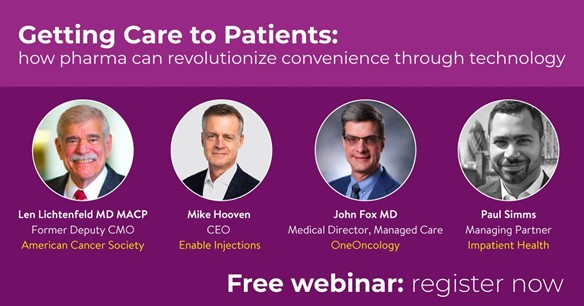
The Activated Patient
Today’s healthcare landscape is rapidly changing – patients and providers are seeing what is possible in terms of patient-centric care. “We are moving into a different era – this doesn’t apply to every patient but will apply more and more – in the sense that patients want more control over their care. I call this the activated patient”, says Lichtenfeld. Fox says, “We have to find ways to improve the patient experience and deliver care in the way that’s best for [patients]. COVID opened our eyes to new opportunities and created new expectations among patients.” “Today, we have options to make care more personalized and flexible. The enFuse is a step forward for patients,” says Lichtenfeld.
The Unmet Need
Fox and Lichtenfeld discuss the increasing demands of flexible options for patients and providers. Fox says, “It is a herculean effort to organize transportation for a day long trek to the oncologist office for an infusion. The ability to deliver in the patient’s home or in the clinic in a very short timeframe will have a lot of benefits for patients and caregivers.”
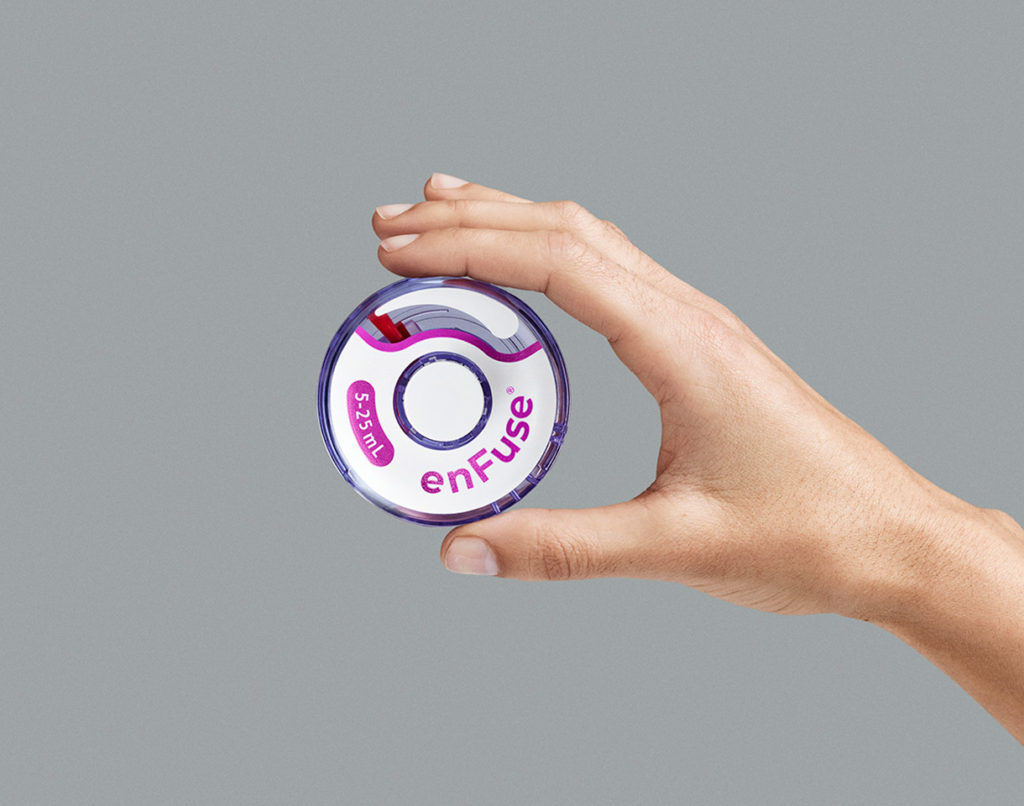
Enable Injections 25 mL enFuse for large volume subcutaneous delivery
“There has been a push in the pharma industry to try to get medications that can be delivered in different ways,” says Lichtenfeld. Alternative delivery approaches are increasingly important due to:
- An aging population
- Increasing autoimmune disease requiring treatment
- Increasing cancer cases
These factors call for the global need to improve efficiencies and accommodate growth.
The Future of Delivery
Patients are burdened with regular visits to the clinic, and immediately recognize the change that the enFuse delivery technology could make in their lives. Patients are no longer bystanders. They expect to be involved in their health decisions.
“With the right drug, someone may get their health back. With the right drug delivery, someone may get their life back.”
enFuse® enables a range of flexible delivery options for patients and healthcare providers, including a range of viscosities, volumes, delivery times, and sites for administration. Mike Hooven says, “We took this very broad approach because we understand that the best solutions are the ones that allow maximum flexibility and options for the patient, provider, and the pharma partner.” Additionally, enFuse® offers EnywhereCareTM flexibility, allowing in-clinic or outside clinic administration with a healthcare provider to at-home self-administration. enFuse is currently available for investigational use only.
Be part of the movement to improve Getting Care to Patients with 700+ Pharma execs, KOLs, tech innovators, and key pharma influencers. Access the webinar content here: https://enableinjections.com/resources/webinars/
To learn more about the enFuse, contact us.
Drug Delivery: What Do Patients and Providers Want?
In this article, originally published at OnDrugDelivery, Matthew Huddleston and Jennifer Estep discuss current drug delivery options and the value of convenient care.
Drug Delivery: What Do Patients and Providers Want?
Worldwide, patient and provider preferences are changing due to the covid-19 pandemic. The need to reduce patient exposure to the virus and free up healthcare resources is driving unprecedented change.
For patients, providers and healthcare systems, the need for more flexible, convenient medical treatment has never been greater. While innovations that improve patient access to care evolve, understanding the needs and wants of patients and providers is more important than ever.
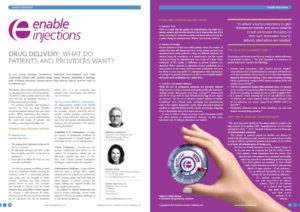
OnDrugDelivery article: Drug Delivery: What Do Patients Want?
CURRENT DRUG DELIVERY OPTIONS
IV Administration
Consider these facts:
- The average time required to place an IV line is 13 minutes1
- IV placement attempts fail 26% of the time in adults and 54% of the time in paediatrics2
- More than one billion IV lines are used annually, worldwide3
Not only are patients unwilling to spend hours in a healthcare facility receiving IV infusions, covid-19 is preventing patients from going into the hospital or clinic. Creative solutions can help improve patient access to care. For example, one provider in Florida (US) has made infusions more accessible to cancer patients by creating a drive-through IV clinic. However, given the amount of time required per IV placement and the IV placement failure rate, it is not surprising that patients prefer subcutaneous (SC) delivery over IV infusion.4
The Step Forward With SC Administration
SC administration enables more flexible delivery options for both the patient and the provider. Current approved delivery options include syringes, autoinjectors, syringe pumps and bolus injectors, which may allow for patient self-administration. However, the full potential of SC delivery has been held back.
Availability of SC Therapeutics –
To date, the number of therapeutics marketed for SC administration is limited despite the advantages SC has over IV administration.
Volume Limitations –
Autoinjectors and syringes traditionally have limits on the volume of therapeutic which can be delivered, typically less than 1.5 mL. This small volume presents formulation challenges to pharmaceutical companies.
Administration Challenges –
Larger volumes delivered with a syringe often require administration by a healthcare professional (HCP). Syringe pumps and bolus injectors allow delivery of greater volumes but require tubing sets, exposed needles and large, cumbersome systems.
In addition to limited therapeutics and delivery volume challenges, several myths plague SC delivery, presenting challenges to its widespread acceptance.
“To deliver volumes necessary to gain therapeutic benefit and allow patients to self-administer therapies on their own, innovative new SC delivery alternatives are needed.”
THREE SUBCUTANEOUS DELIVERY MYTHS
1. Injection Time
There is a belief that the quicker the administration, the better for a patient, caregiver and provider. However, this is often not the case. If the person receiving the treatment is mobile, untethered and not feeling like a patient during an administration,5 delivery time becomes irrelevant.
2. Number of Needles
Recent preference studies have asked patients about the number of needles that they will tolerate per dose. In the studies, patients were questioned about their preference using two different methods: one method being the completion of a questionnaire and the second method involving the administration and receipt of a dose. Upon evaluation of the results, a difference in patient response was identified. When required to administer several needlesticks for a dose, patients in the survey preferred fewer needlesticks and were less likely to state they prefer SC administration with autoinjectors or syringes.6 In general, patients do not like to see or handle needles7 and prefer fewer needlesticks for a single dose.
3. Need for a Permeation Enhancer
While the use of permeation enhancers has provided valuable efficiencies for in-clinic compared with traditional IV administration, multiple studies demonstrate that large volumes8,9,10 administered into the SC tissue with the right delivery technology do not require an enhancer. The use of an enhancer requires addition of further formulation work, clinical trials, packaging and administration steps to the original therapeutic. Lastly, these permeation-enhanced products are typically delivered with a needle and syringe, relegating them to hospital/in-clinic, HCP-supervised use.
In order to deliver volumes necessary to gain therapeutic benefit and allow patients to self-administer therapies on their own, innovative new SC delivery alternatives are needed.
THE VALUE OF CONVENIENT CARE
Convenience and access to care have an impact on patient adherence to prescribed treatments – but how impactful is convenience on patient adherence?
To read more, please visit the article at OnDrugDelivery at this link: https://www.ondrugdelivery.com/drug-delivery-what-do-patients-and-providers-want/
To learn more about ways the enFuse® enables convenient care for patients and providers, contact us.
Reimagining Patient Access to Treatment
Reimagining Patient Access to Treatment
by Mike Hooven, CEO, Enable Injections – LinkedIn Published
Just imagine. Your doctor tells you that your health issues are treatable. Good news, right?
But then, she explains, the treatments involve at least 3 hours each week to receive the medicine. Not such good news.
If you are a student or employee, parent or child, 3 hours per week is disruptive. Those hours add up, and when factoring in travel and preparations, it becomes a significant part of your life. Some would call this a part-time job. Is it really that surprising that the patient adherence rate is less than 50%1?
There has to be a better way.
In my first article of this series, I wrote about the difficulties cancer patients face in getting the care they need, especially during the pandemic. In my second, I discussed the need for innovation to improve patient access to care. Today, I’m calling on more compassion and appreciation of the patient’s burden.
IV treatments are lengthy, costly, difficult to give and receive, and require healthcare teams for administration at home or in the clinic. Autoinjectors and syringes are quick, but have strict delivery volume limitations which necessitate multiple injections at once, often creating confusion and a real aversion for patients opposed to needles.
We must improve the patient experience to help patients get the treatments they need. We must find alternatives to bothersome sit-down infusions, or multiple sticks with large needles.
Solutions do exist, and are worthwhile. The right subcutaneous (SC) delivery solution has the potential to be transformative for both patients and the healthcare system, freeing up patient time, improving patient experience, and providing flexibility for healthcare resources. 
But what are the drawbacks, and are they really legitimate? Some common misconceptions about SC administration include:
1. Dose: Can large volumes of therapeutic be delivered via SC?
Yes. Wearable delivery systems allow patients to go about their lives while they are receiving their therapeutic. And the right large volume wearable delivery system never exposes the needle to the patient.
2. SC capability: Can the skin really absorb medication in large volumes?
Yes. Research has been done to prove safety and efficacy of large volumes of therapeutics when administered via SC. In addition, large volumes of therapeutic do not need additional delivery enhancement to be effective.2
3. Ease: Is administering medication through the skin (SC) really an improvement?
Yes, the impact of SC dosing has been clinically proven to reduce overall time for both patient and provider. When home administration occurred in clinical studies, SC resulted in improved patient quality of life.3, 4 SC delivery solutions, specifically large volume wearable injectors, will allow patients to access improved methods of self-administration over current cumbersome SC systems.
The good news for patients, healthcare providers, pharma, and payers is that there is already technology that delivers the therapeutics that patients need – with large volume wearable injectors in particular providing flexibility for the patient and provider.
With the right subcutaneous delivery system, that 3 hours per week at an infusion clinic or hospital could be significantly reduced or transferred completely to the home. At Enable, we believe the right therapeutic can help patients to get their health back, but the right delivery system can help patients to get their lives back.
Learn More:
Join us in discussion on this topic at upcoming industry webinar with key opinion leaders on April 28 at 10am Eastern US. Click here to register.
References:
1) Sabaté E, ed. Adherence to Long-Term Therapies: Evidence for Action. Geneva, Switzerland: World Health Organization; 2003. https://www.ncbi.nlm.nih.gov/pmc/articles/PMC3068890/
2) Johnson ML, Braiteh F, Grilley-Olson JE, et al. Assessment of Subcutaneous vs Intravenous Administration of Anti–PD-1 Antibody PF-06801591 in Patients With Advanced Solid Tumors A Phase 1 Dose-Escalation Trial. JAMA Oncology. July 2019; 5(7): 999-1007. https://www.ncbi.nlm.nih.gov/pmc/articles/PMC6547134/
3) Abolhassani H, Sadaghiani MS, Aghamohammadi A, Ochs HD, Rezaei N. Home-based subcutaneous immunoglobulin versus hospital-based intravenous immunoglobulin in treatment of primary antibody deficiencies: systematic review and meta analysis. J Clin Immunol. 2012;32:1180–1192. doi: 10.1007/s10875-012-9720-1.
4) Bittner B, Richter W, Schmidt J. Subcutaneous Administration of Biotherapeutics: An Overview of Current Challenges and Opportunities. BioDrugs. 2018;32(5): 425-440. https://www.ncbi.nlm.nih.gov/pmc/articles/PMC6182494/
Delaying Therapy or Risking Exposure: A Decision No One Should Have to Make
Delaying Therapy or Risking Exposure: A Decision No One Should Have to Make
by Mike Hooven, CEO at Enable Injections – LinkedIn published
Over the past 30 years, innovation driven by clinical researchers and the pharmaceutical industry has resulted in new therapies and brighter futures for patients. Today, the global healthcare community’s ability to move swiftly and address unmet needs has never been more evident than the unified efforts we’re seeing around SARS-CoV-2 (COVID-19).
While we have mobilized to meet immediate pandemic needs, we must also continue looking ahead. It’s important to consider how we can apply our collective learnings from this unique moment to drive advances and ignite meaningful changes for patients facing a range of life-threatening conditions in the future.
Insights and Learnings From the Pandemic
The advent of the first global pandemic in nearly a century cast the U.S. healthcare system in a new light. Highlighting the strength and resilience of our institutions and healthcare professionals to mobilize, improvise and rally to support patients, family members and communities, the pandemic also magnified the fragility of the best healthcare system in the world.
Hospitals challenged with an influx of highly contagious patients with intensive medical needs that already faced resource constraints pre-COVID-19 suddenly found themselves bursting at the seams, short of staff and hoping to survive yet another day. While the focus has been on the patients diagnosed with COVID-19, the pandemic’s effects also extend to millions of others whose care has been impacted.
The magnitude and speed with which the virus spread forced healthcare facilities nationwide to redeploy resources, including skilled medical professionals, durable medical equipment and disposable supplies to care for COVID-19 patients. As a result, those with other life-threatening or chronic conditions were often left on the sidelines, with daunting concerns about risk and limited access to care. Consider the following:
- According to a survey conducted through the American Cancer Society’s Survivor Views research panel, the pandemic has had a significant negative impact on cancer patients and survivors currently undergoing treatment.
- In fact, 9% of cancer patients in active treatment reported cancellations or delays in potentially life-saving therapies due to either office or facility closures or concerns about contracting COVID-19.[i]
Those fortunate enough to have access to necessary treatments found themselves in a seemingly no-win scenario, deciding between delaying their treatment or risking exposure to the virus. Researchers from the University of Minnesota reported:
- An estimated 71.9% of patients actively undergoing cancer treatment expressed they were moderately or extremely concerned about contracting COVID-19.
- More than 90% were afraid of “a severe manifestation of the infection.”
- Up to 17.9% of patients reported changing their treatment plans as a result of the pandemic, with risk of exposure being the most commonly cited cause for change (80.8%).[ii]
The pandemic’s impact on oncology treatment is further illustrated with data from recent Avalere analyses of billings for the top-10 brand oncology products (ranked by Medicare Part B spending in 2018). Between February and May 2020, monthly billings for provider-administered oncology therapies were 22% to 50% lower than in the same period in 2019 (-22%, -26%, -39%, -50%).[iii]
We have seen dramatic shifts in how healthcare is practiced due to the pandemic, as reflected in the 300% year over year increase in telehealth visits between March 15 and April 14, 2019, versus 2020.[iv] While the percentage of telehealth visits relative to total healthcare visits has declined since its peak, it remains significantly higher than pre-pandemic rates.[v] While all changes like this won’t necessarily be permanent, it appears that many could be here to stay.
A Vision for the Future
The long-term impact of limited access to cancer services as a result of COVID-19 will not become apparent for some time. However, a 5–10% decrease in cancer survival in high-income countries has been predicted – potentially hundreds of thousands of lives will be lost.[vi] As recently reported in JAMA Oncology, an app has been developed to help oncologists assess the risk/benefit of proceeding with cancer treatment in the COVID-19 environment. While I commend the authors for their work, I would argue the solution is not in better informed decision making – it is in eliminating the need to make such decisions entirely.[vii]
Notably, change has not been swift for those requiring infusion therapy. In the absence of change, the post-pandemic environment for these patients seems to carry the same burdens as before; long hours in a hospital or infusion center receiving treatment in addition to heightened concerns of exposure to the next formidable virus. Currently available therapies will always fall short of their full potential without flexible approaches to delivery and administration that eliminate the need to defer or delay treatment because of access to facilities or concerns about exposure.
It is incumbent upon industry, with the resources and reach to affect real change, to act upon what we’ve learned from the pandemic and pursue approaches that provide patients and healthcare providers with solutions that allow, to the greatest extent possible, flexible administration of life-saving therapeutics either with, or potentially without the assistance of a healthcare provider.
No one wants to face a life-or-death decision about delaying their therapy – and no one should ever have to.
References
[i] American Cancer Society Cancer Action Network (2020). Understanding Access to Care During the COVID-19 Pandemic.
[ii] Lou E., Teoh D., Brown K., Blaes A., Holtan S. G., Jewett P., et al. (2020). Perspectives of Cancer Patients and their Health During the COVID-19 Pandemic. PLOS ONE.
[iii] Young J., Peng J. & Sullivan, M., (2020). Access to Medicare Part B Drugs Remains Challenging During COVID-19. Avalere.
[iv] EHRN (2020). Expansion of Telehealth During COVID-19 Pandemic.
[v] EHRN (2020). Telehealth: Fad or the Future.
[vi] The Lancet Oncology (2020). Safeguarding Cancer Care in a Post-COVID-19 World. The Lancet. Oncology, 21(5), 603.
[vii] The Lancet Oncology (2020). Safeguarding Cancer Care in a Post-COVID-19 World. The Lancet. Oncology, 21(5), 603.
The New Patient-Centricity
The following excerpt is originally published at OnDrugDelivery September 2020 issue, linked here.
THE NEW PATIENT-CENTRICITY
The term “patient-centric” has taken on new meaning in recent months due to the COVID-19 pandemic. For many healthcare-related companies, patient-centric means “a focus on the needs of the patient”. But with pandemic measures in place, patient needs have expanded, and the industry – medical device and pharma companies, healthcare providers, payers and other key stakeholders related to a patient’s care – must adapt to these increased patient needs.
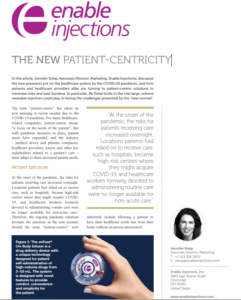
The New Patient-Centricity | OnDrugDelivery September 2020
PATIENT EXPOSURE
At the onset of the pandemic, the risks for patients receiving care increased overnight. Locations patients had relied on to receive care, such as hospitals, became high-risk centres where they might acquire COVID-19, and healthcare workers formerly devoted to administering routine care were no longer available for non-acute care.1 Therefore, the ongoing pandemic situation prompts the question: in the new normal, should the term “patient-centric” now inherently include allowing a patient to
have their healthcare needs met from their home without in-person interaction?
Due to COVID-19, changes in the healthcare system have occurred in a fraction of the usual time. From the patient perspective, Medicare reports a surge in US telehealth visit numbers – from 13,000 beneficiaries pre-pandemic to nearly 1.7 million beneficiaries in the final week of April 2020.2 In hitherto unseen numbers, patients are turning to technology to enable telehealth visits with healthcare providers, which accommodate these new patient needs by allowing for the remote continuation of care.
The risk of exposure to COVID-19 has prompted change from the healthcare provider side as well, including the need to protect patients from exposure at healthcare facilities and prioritise keeping healthcare resources free for acute care. Because of these and other factors, some listed hereafter, large-volume wearable injectors, such as Enable’s enFuse® On-Body Infusor (Figure 1), are likely to be essential elements making this extensive positive shift in healthcare possible, especially on the accelerated timescale mandated by pandemic conditions.
PATIENT BURDEN
Large-volume wearable injector technology may help to reduce patient burden in several ways (Figure 2). For example, large-volume wearable injectors can:
• Enable patients to receive therapeutics at home. Once a therapeutic has been formulated and approved for subcutaneous administration, a patient may be able to self-administer their prescribed therapeutic via a large-volume wearable injector in their home,
whereas they would have previously needed to have their therapeutic administered in a healthcare facility via intravenous administration.
• Reduce the need for a healthcare worker to administer care. The demand for healthcare workers has increased with COVID-19. Large-volume wearable injectors may reduce, or even eliminate, the need for healthcare workers to administer infusions, therefore making them available for urgent COVID-19-related care.
• Reduce patient and healthcare worker exposure. Healthcare workers, patients and caregivers are all exposed when infusions are conducted in person.
Even for situations with a home-infusion set up, a healthcare worker typically has to enter a patient’s home and spends hours in close contact with them during the infusion. Large-volume wearable injector technology has the potential to reduce the need for in-person administration, which reduces the exposure for all involved.
• Reduce the need for patients to leave the home for their healthcare needs. A large-volume wearable injector has the potential to be shipped directly to a patient’s home.
• Communicate data automatically through digital technology. Telehealth-enabled infusion devices allow a patient’s data to be communicated directly with key stakeholders involved in their care. A large-volume wearable injector with digital communication technology would potentially allow the healthcare provider, and others involved in a patient’s care,
to receive updates on the patient’s infusion, as well as reportable metrics which may verify infusion information and patient adherence.
• Reduce the financial burden of therapy. The needs of a patient also extend to their financial burden. By reducing the need for expensive visits to a healthcare facility for infusion, large-volume wearable injectors have the potential to provide economic benefits for the patient and payer, in addition to the healthcare benefits already discussed.
AN ECONOMIC MODEL
Enable Injections has worked with experts in healthcare decision modelling to develop an interactive model that can be used to evaluate the budget impact and cost-effectiveness consequences of an at-home wearable injector.
Click here to read the remainder of the article at OnDrugDelivery.
Key Challenges in Successful Wearable Drug Delivery and Patient Self-Administration
The September 2019 issue of OnDrugDelivery features a new article, Key Challenges in Successful Wearable Drug Delivery and Patient Self-Administration. In the article, Enable Injections’ Matthew Huddleston, Andrew Eibling and Jennifer King look at the key challenges involved in successful wearable drug delivery technology and patient self-administration.
Read an excerpt with a link to the published article, below:
Key Challenges in Successful Wearable Drug Delivery and Patient Self-Administration 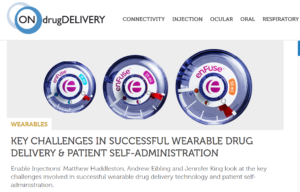
Cutting-edge biologic therapies often require patients to receive treatment through frequent IV infusions at a hospital or infusion clinic. But what would happen if those same biologics could be given by the patient through a simple through-the-skin infusion at home? Why has there not been a greater push for wearable technology that allows people to self-administer infused medicines at home?
Armed with game-changing technology which makes this a possibility, Enable Injections’ goal is to reduce the treatment burden on people living with a wide-range of conditions and put control back into the hands of the patient.
The world is ready for the possibility. US Healthcare costs are increasing at a rate of 3-4% per year1. Evidence shows a reduction in the overall cost when therapy is administered in the home compared to a doctor’s office or clinic2. Patients are ready for it, too. Evidence shows improved compliance and adherence to medications when patients can complete the therapy at home compared to administering infusion in the physician’s office or clinic3. 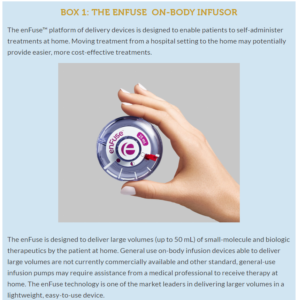
Up to this point, technology has been the limiting factor. Biologic therapies often start with intravenous (IV) infusion and require large volumes for efficacy. Transition to subcutaneous delivery may even require higher volumes due to bioavailability. These large volumes are not suitable for administration via auto-injectors and prefilled syringes. Large infusion pumps are available for subcutaneous delivery in the home, but they are complex, and often require in-home infusion services for administration.
There exists the need for a cost-effective, simple-to-use, large volume, subcutaneous, self-administration infusion system which creates real value for both the pharmaceutical companies and the patients. With the right technology, the market environment is primed to transition.
Click here to read more about Pharma and Patient Challenges in the published article at the OnDrugDelivery website.
Combination Products: Success Is All about the Partnerships
At Enable Injections, we have developed a novel wearable, large volume subcutaneous infusor called the enFuse®. The enFuse is a fascinating design, elegant in its simplicity. As an engineer myself, I marvel at the creativity and skill that has gone into designing and building this innovative delivery device. Enable employees have spent thousands of hours optimizing our technology with the patient in mind. We are all passionate about delivering a superior technology that changes patient lives. The FDA classifies the enFuse as the device constituent of a combination product, which means that in order for the enFuse to deliver on that promise, it must be combined with a drug therapy. Since Enable is a device company, not a drug company, this means that partnerships are critical to our mission.

The Importance of Partnerships
Alliances and partnerships have become pervasive in global industries in the past 20 years. In the biopharmaceutical industry, innovation-based partnerships are a key means of growth. In Q1 of 2019 alone, PricewaterhouseCoopers measured 52 Pharma and Life Science deals worth a staggering $147.3 Billion! Most, if not all, of the top 20 pharmaceutical companies have created internal Alliance Management organizations solely structured to help ensure that these alliances deliver the value intended. I was fortunate enough to be a part of one of the first, the Office of Alliance Management at Eli Lilly and Company in 2000.
Why have so many companies invested so much into the competency of Alliance Management? It is because strategic alliances are difficult and often fail. Based on a 2015 Vantage Partners survey, only 41% of strategic alliances fully achieve their stated objectives. When two organizations combine with different cultures, capabilities, incentives, working styles, operating practices, and risk profiles, the collaboration is bound to have challenges. Without the right expertise and support, the alliance relies on luck to achieve its goals.
While all alliances are challenging, additional challenges emerge when companies in different industries partner. For example, much has been made of the tech titans entering the healthcare space. Pharma and other healthcare companies are now partnering with companies like Google, Amazon, IBM and others that grew up in the world of technology. Putting these companies together is like mixing oil and water. On one hand, the risk averse, highly-regulated companies have rigid processes to manage quality and patient safety and have lengthy product development life cycles of 10 years. On the other, companies that are bred and trained to take risks operate by moving quickly to stave off extinction. These two different types of companies speak different languages with different acronyms that could fill volumes. These types of counter-cultural partnerships require real work to ensure the relationship works well and achieves its goals.
Partnerships with Combination Products
We face similar challenges in the combination product realm. Device companies are staffed with engineers and human factors experts, among others. Pharma companies are life science-based, with chemists, biologists, clinicians, toxicologists and the like. Product design and development processes and development cycles are vastly different. We, too, use different language and acronyms and typically work at a different pace. But at the core, we find commonality in our focus on patients. That is where the magic happens. Whatever differences and challenges we have can be simplified by being reminded of our common bond and the impact we can only have by working together.
We have done a couple of things at Enable to try to maximize our partnership success. First, we have augmented our device expertise by bringing in staff with pharmaceutical backgrounds. Having the combined expertise in-house allows us to more easily consider multiple perspectives, translate terminology, and predict intentions and incentives. We spend a lot of time educating each other, which helps us immensely as we work with our pharma partners. Second, we have invested in establishing an alliance management competency. Many of our partners, unfortunately, don’t allocate their alliance management resources to device partnerships, so we believe by assuring we are implementing best practices in support of the relationship, we can maximize success and ensure that our joint innovation reaches its intended target – the patient. We are still growing and evolving but have established a solid foundation.
One last thought on the topic of partnerships. We tend to think broadly about the partnerships that will be necessary to deliver our disruptive technology: the four P’s – Pharma, Patients, Physicians and Payers. We will have to work effectively with all four if we are to be successful.
We are working to ensure we have active and continuous dialog with each of them. We don’t have all the answers yet and only by working together will those answers be developed. However, patients must remain at the center. While not a “consumer-facing” company, our enFuse device will soon be used daily by millions of patients around the globe. We have conducted many, many, studies to ensure we really understand them – what is important to them, what they worry about, what they like and don’t like about their current treatment options, and how they would use our device. We have made many adjustments and improvements over the years to ensure that our device is designed to be intuitive and convenient with the ultimate goal of making patients’ lives easier.
It is a journey that won’t end for us. Engineers are always seeking to improve upon designs and patients will continue to challenge us to find new ways to make treatment easier. Personally, I can’t wait to see what’s in store and I am looking forward to having millions of patients benefit from what our team has developed. And it will all happen through the partnerships we develop and nurture.
Author: Andy Eibling, CSAP, VP, Business Development and Alliance Management, Enable Injections
Patient Tolerability with High-Viscosity, Large-Volume Subcutaneous Infusions
The need for something different
Traditional methods of subcutaneous drug delivery include autoinjectors and infusion pumps. These delivery regimens allow for small-volume delivery of low-viscosity drugs, with a high value placed upon minimizing delivery time – getting the drug into the injection site as quickly as possible. Patient experience is becoming more important, as it relates to overall drug efficacy and safety.
The introduction of biotherapeutics, which require higher concentrations of active pharmaceutical ingredient to meet efficacy requirements, has not only challenged the previously established limits of volume, viscosity, and flowrate, but the devices used to deliver them. The trend for subcutaneous administration is moving to large-volume injections of high-viscosity drugs. But there are many questions that are not well understood. What is it like to inject 5, 10, 15 milliliters (mL) and greater volumes of a high-viscosity biotherapeutic into subcutaneous tissue at high flowrates? More importantly, can the patient continue to tolerate this approach?
Many peer-reviewed studies1, 2, 3, 9 have focused on administration volumes of up to 3 mL, flowrates of up to 10 mL per minute, and viscosities of up to 50 centipoise. These studies have been singularly focused on one or two of the abovementioned performance attributes due to limitations with the devices used for delivery. Data is needed on patient tolerability with the combination of large volumes, various flow rates, and higher viscosities associated with subcutaneous infusion.
Devices need to adapt to this new class of drugs. The best design will incorporate a unique set of device attributes and requirements, as well as anticipate key drug and patient variables to produce a safe and efficacious delivery, while maximizing a positive patient experience.
Device Variables and Considerations
Key device design characteristics that may influence patient experience and tolerability during subcutaneous infusion of high-viscosity, large-volume therapeutics include flow rate, skin/needle interface, and needle size. These attributes are discussed further below with respect to patient impact. It is also likely that these variables are interdependent.
Flow Rate
Previous studies3 have focused on high speed injection (autoinjectors) or constant flowrate delivery (infusion pumps) of drugs. The value proposition has been to minimize injection time or allow for a fixed injection time, both of which are preferred. This may be true if the user needs to hold an injection device against their skin or be tethered to an infusion pump. However, infusion time may become less relevant if the user is uninhibited during daily activities while receiving therapy, such as using an on-body delivery device.
At Enable, we believe a slower flowrate (and the associated longer injection time) will be preferred by the patient and improve tolerability of large volumes. It is hypothesized that slower flowrates could lead to a lower incidence of site reactions and injection pain.
Skin / Needle Interface (Tissue Tent)
In general, previous studies6, 7, 9 have investigated subcutaneous injections with the use of syringe and needles or infusion sets utilizing butterfly needles. In either case, the user or provider has the ability to control the depth of the needle by either pinching or stretching the tissue at the injection site prior to needle insertion.
The Enable enFuse® wearable technology includes a tissue tent feature on the bottom of the device to automatically stretch the tissue at the injection site. The tissue tent feature is designed to ensure the needle inserts to the correct depth and that drug is delivered into the appropriate anatomical space.
The tissue tent may also provide a secondary benefit by applying a small amount of pressure at the injection site, which may have several advantages. Injection site pressure could reduce the needle insertion pain by disrupting the tissue at the injection site, similar to a nurse pressing on the injection site prior to needle insertion. It is hypothesized that pressure at the injection site could encourage a deeper deposit of drug into the subcutaneous space, especially in cases of larger volume delivery. It could also potentially prevent leakage and backflow, similar to a nurse applying pressure to the injection site at the completion of delivery.
Needle Size
Previous studies have generally investigated subcutaneous injections/infusions with the use of syringe and needles or infusion sets utilizing butterfly needles. These needles4 range from 31 to 26 gauge, with the majority being larger needle size. Other publications have theorized that smaller gauge needles introduce greater discomfort due to increased fluid velocity at a constant flowrate10, 11. Flowrate in conjunction with needle size could be important.
At Enable, we believe a smaller needle size is preferred based on our experience that smaller needle sizes produce less injection site pain6, 7 and less leakage and backflow.
Drug Variables and Considerations
Drug-contributing characteristics that impact patient tolerability of high-viscosity, large-volume subcutaneous infusion must be considered, which includes delivery volume and viscosity.
Volume and Viscosity
The Enable technology is designed to deliver up to 50 mL of drug product independent of viscosity at a specified subcutaneous site. Studies suggest that injection site pressure is less affected by volume and more dependent on viscosity7, 9. Typically, pharmaceutical companies have had the mindset to pursue high-concentration (high-viscosity) and low-volume formulations based on limitations with previously available delivery systems.
Enable is encouraging pharma and biopharmaceutical companies to take advantage of the high-volume enFuse platform to facilitate drug product formulation development for subcutaneous administration by allowing flexibility in the drug concentration and delivery volume.
Other Drug-Specific Attributes
Other drug-specific variables which affect patient tolerability may include pH, osmolality, excipients, and temperature. Much is known5 about patient tolerability with low-volume subcutaneous injections, but what is the pain tolerance and how is it affected by these drug-specific attributes of the therapeutic?
Patient Variables and Considerations
Injection Pressure and Backpressure
The Enable enFuse® utilizes a constant, relatively low pressure mechanism to deliver the drug to the subcutaneous space. Unlike constant flowrate infusion pumps, the enFuse platform automatically adjusts the flowrate of the drug based on the backpressure being created within the injection site. This is fundamentally different and potentially advantageous to patient preference and tolerability compared to constant flowrate pumps.
Previous studies2, 8 have investigated tissue backpressure as a function of flowrate, viscosity, and delivered volume. However, all of these studies were executed with constant flowrate pumps.
Patient Characteristics<
The abdomen is a popular location for subcutaneous injections, due to its easy access and amount of available space. Additional sites, including the inner thigh and back of the arm, could also be considered for subcutaneous injection, although the suitability of these sites for larger infusion volumes is not established. The impact of other patient demographics, such as Body Mass Index (BMI) and skin integrity/type, on infusion and patient tolerability should also be evaluated.
The Enable enFuse®
The patient experience must be an integral part of the device design process to ensure overall safety and efficacy of a drug-device or biologic-device combination product. The Enable enFuse is intuitively designed to incorporate these device and patient-centric features to ensure dose accuracy and reliability while maximizing a positive patient experience.
Enable Injections is invested to improve the patient experience for large-volume subcutaneous administration of high-viscosity therapeutics with the enFuse platform. To learn more, visit our Technology page or contact us.
Author:
Matt Huddleston, EVP and Chief Technology Officer, Enable Injections
Resources:
- Berteau, C, et al. “Evaluation of the impact of viscosity, injection volume, and injection flow rate on subcutaneous injection tolerance.” Med Devices, 2015 Nov 11;8:473-84. doi: 10.2147/MDER.S91019. eCollection 2015. https://www.ncbi.nlm.nih.gov/pmc/articles/PMC4646585/. Accessed 18FEB2019.
- Zijlstra, E, et al. “Impact of Injection Speed, Volume, and Site on Pain Sensation.” Journal of Diabetes Science and Technology, 2018 Jan; 12(1): 163-168. https://www.ncbi.nlm.nih.gov/pmc/articles/PMC5761988/ Accessed 18FEB2019.
- Praestmark, K, et al. “Injection Technique and Pen Needle Design Affect Leakage from Skin After Subcutaneous Injections.” Journal of Diabetes Science and Technology, 2016 Jun 28; 10(4): 914-22. https://www.ncbi.nlm.nih.gov/pmc/articles/PMC4928216/ Accessed 18FEB2019.
- Juul, K, et al. “Influence of hypodermic needle dimensions on subcutaneous injection delivery–a pig study of injection deposition evaluated by CT scanning, histology, and backflow.” Skin Research and Technology, 2012 NOV; 18(4): 447-55. https://www.ncbi.nlm.nih.gov/pubmed/22233448
- Dias, C, et al. “Tolerability of High-Volume Subcutaneous Injections of a Viscous Placebo Buffer: A Randomized, Crossover Study in Healthy Subjects.” AAPS PharmSciTech, 2015 OCT; 16(5). https://www.ncbi.nlm.nih.gov/pmc/articles/PMC4674646/ Accessed 18FEB2019.
- Doughty, D, et al. “Understanding Subcutaneous Tissue Pressure for Engineering Injection Devices for Large-Volume Protein Delivery.” Journal of Pharmaceutical Science, 2016 JUL; 105(7); https://www.ncbi.nlm.nih.gov/pubmed/27287520 Accessed 18FEB2019.
- Allmendinger, A, et al. “Measuring tissue back-pressure–in vivo injection forces during subcutaneous injection.” Pharmaceutical Research, 2015 JUL; 32(7). https://www.ncbi.nlm.nih.gov/pubmed/25537343. Accessed 18FEB2019.
- Torjman, M, et al. “Evaluation of an investigational wearable injector in healthy human volunteers.” Expert Opinion Drug Delivery, 2017 JAN; 14(1): 7-13. https://www.ncbi.nlm.nih.gov/pubmed/27809609 Accessed 18FEB2019.
- Patte, C, et al. “Effect of infusion rate and indwelling time on tissue resistance pressure in small-volume subcutaneous infusion like in continuous subcutaneous insulin infusion.” Diabetes Technology & Therapeutics, 2013 April; 15(4). https://www.ncbi.nlm.nih.gov/pubmed/23427865 Accessed 18FEB 2019.
- Alam, M, et al. “Effect of Needle Size on Pain Perception in Patients Treated with Botulinum Toxin Type A Injections: A Randomized Clinical Trial.” JAMA Dermatol. 2015 NOV. https://jamanetwork.com/journals/jamadermatology/fullarticle/2436035. Accessed 18FEB2019.
- Pathak, P, et al. “Effect of Needle Gauge on Perception of Pain Intensity among Infants Receiving D.P.T. Vaccination.” Nursing and Midwifery Research Journal, Vol-3, No.4, Oct 2007. https://medind.nic.in/nad/t07/i4/nadt07i4p172.pdf Accessed 18FEB2019.

